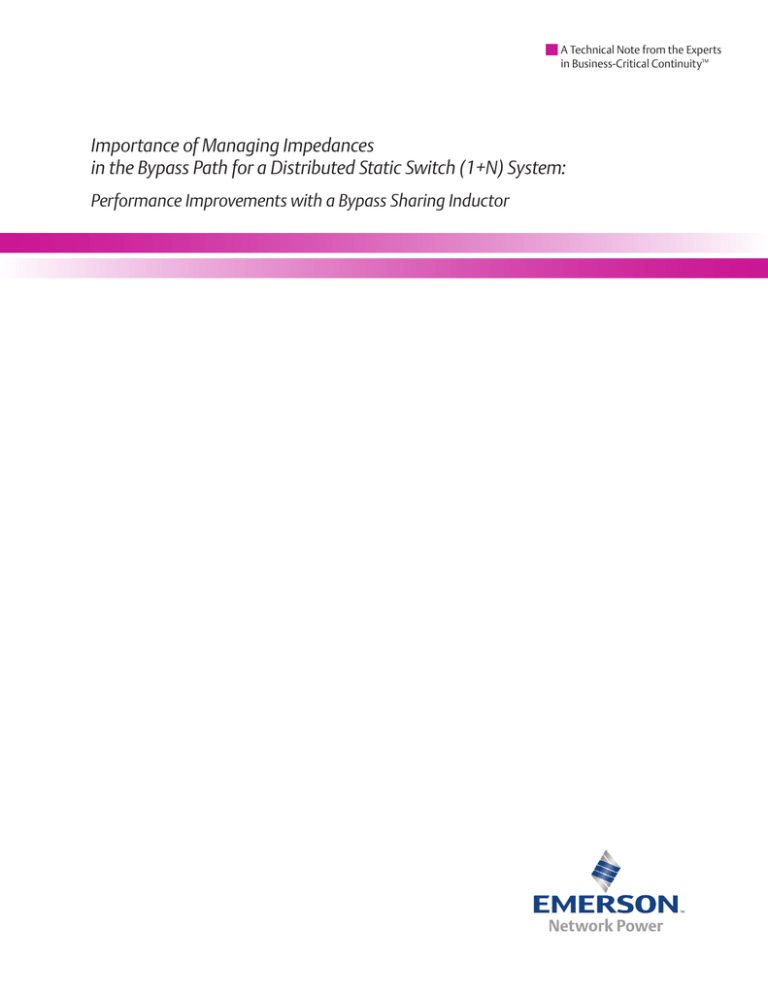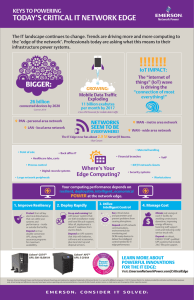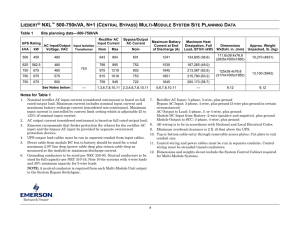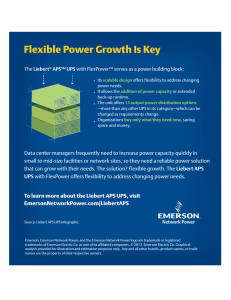
A Technical Note from the Experts
in Business-Critical Continuity™
Importance of Managing Impedances
in the Bypass Path for a Distributed Static Switch (1+N) System:
Performance Improvements with a Bypass Sharing Inductor
Introduction
This paper explains how the impedances of the bypass paths should be controlled for
paralleled distributed static switch (1+N) UPS systems and provides recommendations for
controlling the cabling impedances to ensure efficient bypass power sharing.
When a system is on inverter, the inverter power sharing algorithm controls each UPS
module’s output voltage magnitude and phase angle to evenly distribute the power. However,
when the system is on bypass, the power flows through the Backfeed Breakers (BFB) and
Bypass Static Switches (BPSS) and is not actively controlled. Bypass current sharing can only
be achieved by controlling the impedance difference between each unit. For this reason, a
Sharing Inductor is included with the Liebert NXL UPS to permit some variation of cable length
(and impedance) while maintaining equivalent load sharing between units.
For example, if two UPS modules without sharing inductors are paralleled and the impedance
in each bypass path is identical then each unit will have exactly 50% of the load. Any mismatch
in the impedance will cause one unit to have more than 50% of the load while the other UPS
will have less than 50%.
For a redundant system Emerson Network Power defines the worst case system load rating
with the redundant module out of service. Our philosophy is that the customer’s load should
be supported if there is enough connected UPS capacity to support the critical load. For
example, in the case of a Liebert NXL three (3) module system, if the system is on the static
bypass switches and the customer’s load is 3 x 100% of the module ratings, the system should
NEVER shutdown due to imbalance in load sharing between units.
Therefore, in order for each module to carry its’ rated load, it is important for the impedances
in the bypass paths to be sufficiently matched. Otherwise, if they are not closely matched, a
100% system load could cause one UPS to have, for example, 120% of the load current while
the other UPS only has 80% and thus one UPS will begin an overload shutdown time.
2
Bypass Sharing Operating in Redundancy
and Capacity Modes
Operating in a redundant mode implies
that there is at least one more UPS module
online than needed to support the total
critical load. In this scenario accurate bypass
sharing is not very critical since the load on
the bypass path of each module will never be
near 100% of the full load capacity.
Operating in a capacity mode system implies
that there are only enough UPS modules
available to support the load. In other
words, each UPS bypass must share the
load equally. Getting the bypass circuits to
share the current is strictly a function of the
impedance difference between each unit’s
bypass paths.
Figure 1 shows the simplified electrical
circuit for the bypass paths in a Liebert NXL
1+N system. The circuit is composed of three
(3) major impedance elements, namely the
input cabling impedance (1), the bypass
Sharing Inductor (2) and the output cabling
impedance (3). These three impedance
elements are summed together to create
the total impedance of the bypass path. For
the data that will be presented next, the
cabling impedance is the sum of both the
input and output field cabling to the UPS. It
is assumed that the Input Switchgear, circuit
breakers, and System Paralleling Cabinet
have negligible impedance. In the example,
the cabling chosen is 600kcmil per phase.
MBB
MIB
UPS Module
Input
Switchgear
BFB
1
CB1
2
DC
Bus
Rectifier
System
Paralleling
Cabinet
3
Inverter
CB2
MOB
AC
UPS Module
BFB
CB1
DC
Bus
Rectifier
Inverter
CB2
MOB
UPS Module
BFB
CB1
DC
Bus
Rectifier
Inverter
CB2
MOB
Figure 1 - 1+N Bypass Electrical Circuit
3
Bypass Power Sharing with Cabling
Impedance Differences
Based on a 1+N system of (3) 750kVA 480V
Liebert NXL with 2,250kVA of load at 0.9
lagging power factor, Table 1 shows the
bypass loads when the cabling length is
varied while UPS modules power the load via
their static bypass switches with a Sharing
Inductor. The percent difference shown
is based on UPS1 & UPS2 with the cable
lengths as listed and UPS3 bypass cabling
is reduced by the percentage in the table.
Tables 2 shows the current sharing difference
with share inductors not installed. The red
shaded data indicates an overload situation.
The values over 110% are an unacceptable
overload.
Table 1: Bypass Current Sharing
Liebert NXL with Share Inductor (4) 600kcmil per phase
100% System load 750kVA,480V, 0.9pf, 50ft
Percent cable Difference
% Current UPS #1
% Current UPS #2
% Current UPS #3
0% (50, 50, 50)
100.0%
100.0%
100.0%
10% (50, 50, 45)
99.8%
99.8%
100.4%
25% (50, 50, 37.5)
99.4%
99.4%
101.2%
50% (50, 50, 25)
98.7%
98.7%
103.4%
100% System load 750kVA,480V, 0.9pf, 100ft
Percent cable Difference
% Current UPS #1
% Current UPS #2
% Current UPS #3
0% (100, 100, 100)
100.0%
100.0%
100.0%
10% (100, 100, 90)
99.8%
99.8%
100.4%
25% (100, 100, 75)
98.5%
98.5%
103.0%
50% (100, 100, 50)
96.5%
96.5%
107.0%
100% System load 750kVA,480V, 0.9pf, 200ft
Percent cable Difference
% Current UPS #1
% Current UPS #2
% Current UPS #3
0% (200, 200, 200)
100.0%
100.0%
100.0%
10% (200, 200, 180)
99.3%
99.3%
101.5%
25% (200, 200, 150)
97.0%
97.0%
106.0%
50% (200, 200, 100)
93.0%
93.0%
114.0%
100% System load 750kVA,480V, 0.9pf, 500ft
Percent cable Difference
% Current UPS #1
% Current UPS #2
% Current UPS #3
0% (500, 500, 500)
100.0%
100.0%
100.0%
10% (500, 500, 450)
99.0%
99.0%
102.0%
25% (500, 500, 375)
95.5%
95.5%
109.0%
50% (500, 500, 250)
89.0%
89.0%
122.0%
4
Table 2: Bypass Current Sharing
Other manufacturers UPS without Share Inductor (4) 600kcmil per phase
100% System load 750kVA,480V, 0.9pf, 50ft
Percent cable Difference
% Current UPS #1
% Current UPS #2
% Current UPS #3
0% (50, 50, 50)
100.0%
100.0%
100.0%
10% (50, 50, 45)
96.5%
96.5%
107.0%
25% (50, 50, 37.5)
90.0%
90.0%
120.0%
50% (50, 50, 25)
75.0%
75.0%
150.0%
100% System load 750kVA,480V, 0.9pf, 100ft
Percent cable Difference
% Current UPS #1
% Current UPS #2
% Current UPS #3
0% (100, 100, 100)
100.0%
100.0%
100.0%
10% (100, 100, 90)
96.5%
96.5%
107.0%
25% (100, 100, 75)
90.0%
90.0%
120.0%
50% (100, 100, 50)
75.5%
75.5%
149.0%
100% System load 750kVA,480V, 0.9pf, 200ft
Percent cable Difference
% Current UPS #1
% Current UPS #2
% Current UPS #3
0% (200, 200, 200)
100.0%
100.0%
100.0%
10% (200, 200, 180)
97.0%
97.0%
106.0%
25% (200, 200, 150)
90.0%
90.0%
120.0%
50% (200, 200, 100)
75.5%
75.5%
149.0%
100% System load 750kVA,480V, 0.9pf, 500ft
Percent cable Difference
% Current UPS #1
% Current UPS #2
% Current UPS #3
0% (500, 500, 500)
100.0%
100.0%
100.0%
10% (500, 500, 450)
97.0%
97.0%
106.0%
25% (500, 500, 375)
91.0%
91.0%
118.0%
50% (500, 500, 250)
76.0%
76.0%
148.0%
Table 1 – Affects of cabling impedances
The bypass static switch of each Liebert NXL
UPS is rated for 110% continuous. Any unit
with a bypass current in excess of the 110%
limit will initiate an overload timeout for the
entire system. Without an overload timeout
a bypass circuit can be overloaded causing
protection devices to trip without warning.
A comparison of Table 1 and Table 2
demonstrates that controlling the cabling
impedance (i.e., cable size and length) is very
important if the bypass paths are to share the
load current without getting into an overload
situation prematurely.
5
Recommendations
Emerson Network Power recommends that the impedance in the bypass path be carefully
matched for paralleled systems.
The impedance mismatch can be minimized by controlling the wiring length of each unit.
In other words, the installation of a parallel system requires that the cabling impedance be
as closely matched as possible. The design and the layout of the UPS system and associated
panels and cabling should be examined closely to ensure that cable lengths and impedances
are closely matched. To minimize the impact of cable impedance mismatch the Liebert 1+N
UPS module is supplied with a sharing reactor.
The cabling impedance must be carefully controlled to ensure good bypass current sharing.
1. For Liebert NXL Systems, the cabling impedances need to be within 10% from maximum
to minimum. If the cabling impedances need to be greater than 10%, contact your
Emerson representative to calculate if the system will result in an overload condition when
operating on bypass.
2. When bringing the 1+N system online for the first time or after removing one unit, it is
recommended that the bypass current mismatch be checked. This is accomplished by
placing a load on the bypass of each UPS module and then viewing the output current
of each unit. The accuracy of the currents displayed on the UPS module is sufficient for
this check. If the mismatch is greater than 10% it will be necessary to balance the bypass
impedances or limit the load to less than maximum rating.
6
Emerson Network Power
1050 Dearborn Drive
P.O. Box 29186
Columbus, Ohio 43229
800.877.9222 (U.S. & Canada Only)
614.888.0246 (Outside U.S.)
Fax: 614.841.6022
EmersonNetworkPower.com
Liebert.com
While every precaution has been taken to ensure accuracy and
completeness in this literature, Liebert Corporation assumes no
responsibility, and disclaims all liability for damages resulting
from use of this information or for any errors or omissions.
© 2011 Liebert Corporation. All rights reserved throughout
the world. Specifications subject to change without notice.
All names referred to are trademarks or registered trademarks
of their respective owners.
®Liebert and the Liebert logo are registered trademarks of the
Liebert Corporation. Business-Critical Continuity, Emerson Network
Power and the Emerson Network Power logo are trademarks and
service marks of Emerson Electric Co. ©2011 Emerson Electric Co.
TN-00009-R06-11
Emerson Network Power.
The global leader in enabling Business-Critical Continuity™.
AC Power
Connectivity
DC Power
Embedded Computing
Embedded Power
Infrastructure Management & Monitoring
Printed in USA
EmersonNetworkPower. com
Outside Plant
Power Switching & Controls
Precision Cooling
Racks & Integrated Cabinets
Services
Surge Protection





